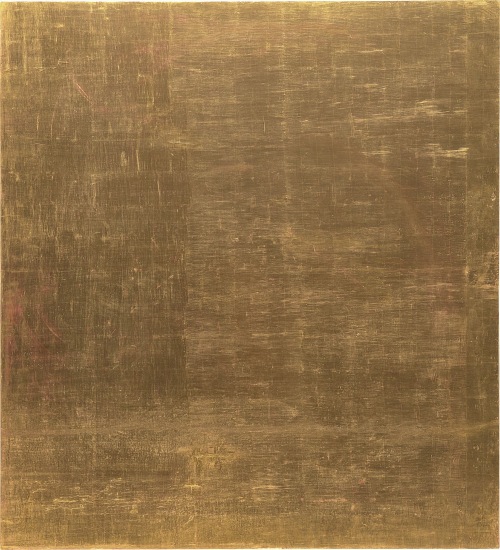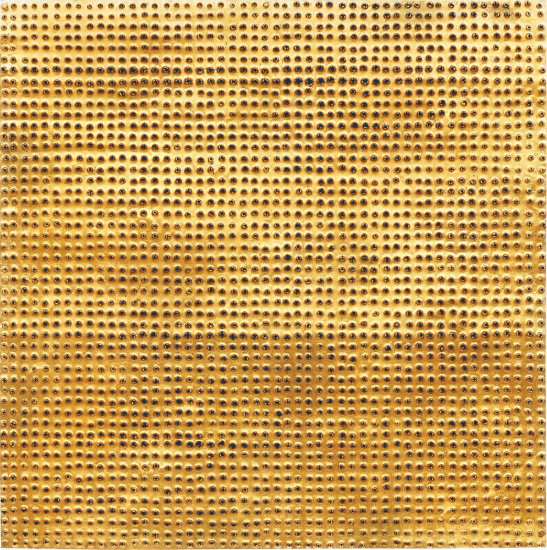Mathias Goeritz Mensaje dorado 1960 thin perforated gold metal on wood 31 1/2 x 31 1/2 in. (80 x 80 cm) Signed and date "MG.60," on the reverse. This work is accompanied by a certificate of authenticity issued by Lily Kassner.
Provenance Acquired directly from the artist Howard Wise Gallery, New York Private Collection, Texas Catalogue Essay In 1958, following the death of his former wife and dedicated partner, Marianne Gast, Mathias Goeritz entered a deep depression that profoundly affected his artistic production. During his mourning period he began working on a series of works that he would later title Mensajes or Messages. These particular pieces, which vary in size and materials, all center on an assemblage technique that functioned as a sort of meditation that the artist performed through a series of repetitive actions. The present lot is an exceptional example of this type of work and exemplifies the many elements that make this series so important within Goeritz’s oeuvre, as well as mid-twentieth century modern art on a much broader scale. Mathias Goeritz born in Danzig in 1915, came of age during the turbulent interwar period in Germany. In Berlin he studied philosophy and the history of art before moving to Morocco in 1941 followed by Spain in 1945, where he lived until 1948. During this formative period, Goeritz became fascinated by the artistic avant-garde and the role of abstraction within modern art. By the time the artist moved to Mexico in 1949 with his wife, Marianne Gast, Goeritz had built a career for himself as a cultural promoter and begun fomenting his theories for a truly modern approach to both art and architecture. During his early years in Mexico, Goeritz came to develop the idea of emotional architecture, which would characterize this period in his art and on which he would build his reputation within the country. Through this concept, Goeritz proposed that architecture should not be overpowered by the singular importance of functionality and should rather engage humankind with its beauty, creating an emotive response. His stimulating and passionate personality helped gain him many commissions, allowing the artist to execute important projects all over Mexico City during this time, including the Torres de Ciudad Satélite (1957-1958). However, it was during this prolific period in his career that he also separated from Marianne Gast and then lost her permanently after she became ill and died in 1958. As previously mentioned, Goeritz’s emotional reaction to this tragedy was profound and he transitioned from making such monumental public works to his Mensajes, which are decidedly more intimate and personal. Many of these works feature painted wooden supports covered by thin sheets of metal that are painted in luminous shades of gold. Furthermore, Goeritz manipulated the gold surface with a series of violent, repetitive punctures that create a sort of constellation that mesmerizes the viewer. Visually, these abstract works are on par with the likes of Lucio Fontana and Yves Klein but in this particular series Goeritz’s intention did not relate to pushing the boundaries of painting or abstract art. Rather, the Mensajes are fundamentally about a healing process based on exploring one’s own spirituality. It would be easy to assume that this series went under the radar because of its personal nature, but in fact the opposite is true. Goeritz first exhibited these works in Mexico City at the Inés Amor’s seminal Galería de Arte Mexico, followed by a second exhibition at the Carstairs Gallery in New York in 1960. In New York, Goeritz further cemented his notions that art must come from a place of spirituality within the artist himself, as he reacted against the bold and often destructive nature of Abstract Expressionism he witnessed in the city. His continuation and development of the Mensajes series was an intrinsic reaction to the futility he observed in artists’ creating art that lacked an inner element of self-reflection. With this still in mind, Goeritz returned to Mexico after an exhibition in Paris to exhibit once more in his adopted home country at the Antonio Souza Gallery. His work inspired his peers and led to the format
Mathias Goeritz Mensaje dorado 1960 thin perforated gold metal on wood 31 1/2 x 31 1/2 in. (80 x 80 cm) Signed and date "MG.60," on the reverse. This work is accompanied by a certificate of authenticity issued by Lily Kassner.
Provenance Acquired directly from the artist Howard Wise Gallery, New York Private Collection, Texas Catalogue Essay In 1958, following the death of his former wife and dedicated partner, Marianne Gast, Mathias Goeritz entered a deep depression that profoundly affected his artistic production. During his mourning period he began working on a series of works that he would later title Mensajes or Messages. These particular pieces, which vary in size and materials, all center on an assemblage technique that functioned as a sort of meditation that the artist performed through a series of repetitive actions. The present lot is an exceptional example of this type of work and exemplifies the many elements that make this series so important within Goeritz’s oeuvre, as well as mid-twentieth century modern art on a much broader scale. Mathias Goeritz born in Danzig in 1915, came of age during the turbulent interwar period in Germany. In Berlin he studied philosophy and the history of art before moving to Morocco in 1941 followed by Spain in 1945, where he lived until 1948. During this formative period, Goeritz became fascinated by the artistic avant-garde and the role of abstraction within modern art. By the time the artist moved to Mexico in 1949 with his wife, Marianne Gast, Goeritz had built a career for himself as a cultural promoter and begun fomenting his theories for a truly modern approach to both art and architecture. During his early years in Mexico, Goeritz came to develop the idea of emotional architecture, which would characterize this period in his art and on which he would build his reputation within the country. Through this concept, Goeritz proposed that architecture should not be overpowered by the singular importance of functionality and should rather engage humankind with its beauty, creating an emotive response. His stimulating and passionate personality helped gain him many commissions, allowing the artist to execute important projects all over Mexico City during this time, including the Torres de Ciudad Satélite (1957-1958). However, it was during this prolific period in his career that he also separated from Marianne Gast and then lost her permanently after she became ill and died in 1958. As previously mentioned, Goeritz’s emotional reaction to this tragedy was profound and he transitioned from making such monumental public works to his Mensajes, which are decidedly more intimate and personal. Many of these works feature painted wooden supports covered by thin sheets of metal that are painted in luminous shades of gold. Furthermore, Goeritz manipulated the gold surface with a series of violent, repetitive punctures that create a sort of constellation that mesmerizes the viewer. Visually, these abstract works are on par with the likes of Lucio Fontana and Yves Klein but in this particular series Goeritz’s intention did not relate to pushing the boundaries of painting or abstract art. Rather, the Mensajes are fundamentally about a healing process based on exploring one’s own spirituality. It would be easy to assume that this series went under the radar because of its personal nature, but in fact the opposite is true. Goeritz first exhibited these works in Mexico City at the Inés Amor’s seminal Galería de Arte Mexico, followed by a second exhibition at the Carstairs Gallery in New York in 1960. In New York, Goeritz further cemented his notions that art must come from a place of spirituality within the artist himself, as he reacted against the bold and often destructive nature of Abstract Expressionism he witnessed in the city. His continuation and development of the Mensajes series was an intrinsic reaction to the futility he observed in artists’ creating art that lacked an inner element of self-reflection. With this still in mind, Goeritz returned to Mexico after an exhibition in Paris to exhibit once more in his adopted home country at the Antonio Souza Gallery. His work inspired his peers and led to the format










.jpg)




Try LotSearch and its premium features for 7 days - without any costs!
Be notified automatically about new items in upcoming auctions.
Create an alert